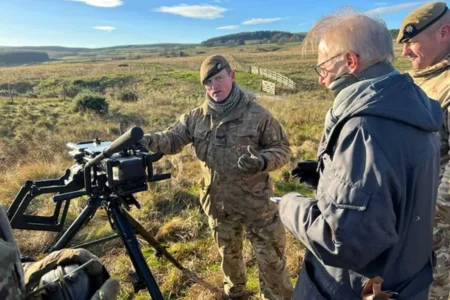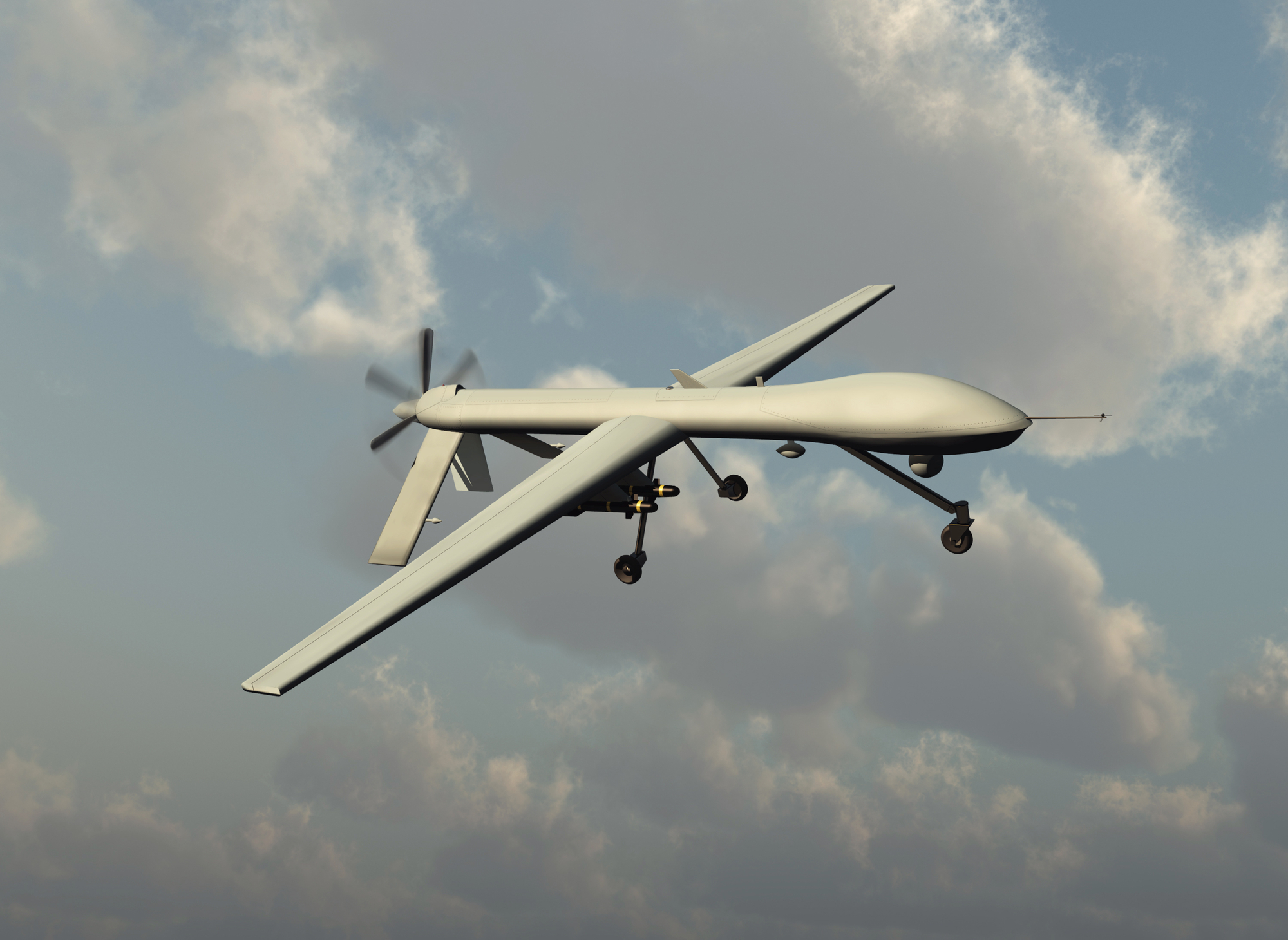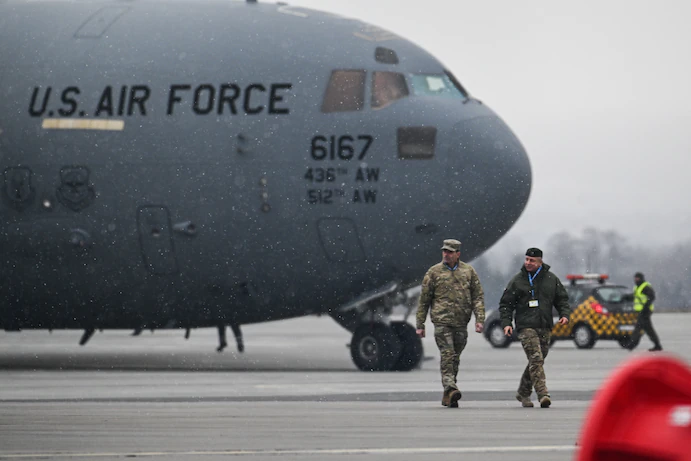
We translated the second part of an interesting article from the Washington Post about technologies that help the Ukrainian army win the war against Russia. Read the first part here.

North-Eastern Great Britain. To see the human face of the “algorithm war” in Ukraine, visit the recruits who are being trained in Britain. This happens for five weeks, and then they get to the Ukrainian front.
Soon they will receive high-tech systems that will help them in battles. But first they need to get used to the mud of the trenches and the constant roar of artillery: the physical battlefield is as important as the digital one.
In the British camp, the instructors dug about 300 m of trenches on the cold hillside. The trenches are more than 1 m deep, with sandbags and boards along them, and mud and water underfoot.
Tame Power BI and predict the future of your company.
REGISTER!
Ukrainian recruits who have not been in combat before have to spend 48 hours in these terrible holes. Sometimes they imitate the sounds of artillery fire and put rotting animal meat nearby so that future soldiers get used to the smell of death.
Recruits practice attacking and defending trenches. But mostly they learn how to stay alive, how to keep warm and how not to freeze wet feet. “Nobody likes the trenches,” says Oleg, a Ukrainian officer training alongside his British counterparts. (I’m not using his full name to avoid danger). “We tell them that it is difficult now, but it will be easier in battle.”
The paradox of the Ukrainian war is the combination of the horrors of the trenches of the First World War and modern weapons of the 21st century.
“It is difficult to understand the brutality of the clashes on this front line. This is Passchendaele in Donetsk,” explains Brigadier General Justin Stenhouse, recalling one of the bloodiest battles of the First World War. He is training for the British Ministry of Defense in Whitehall and organized my visit to the training camp.
Lieutenant Colonel John Harris, the British commander of the camp, formulates the mission of the camp as follows: “Learn to survive and defeat the Russians.”
Silicon Valley Pentagon
The war in Ukraine is a combination of the courage of the military and the amazing technology that I described in the first part. The result is success in military operations. These technologies were not often discussed in the media, but they have been developed for many years. We’re seeing their effectiveness now, and it raises some uncomfortable questions about how that power might be used.
One of the leading players in this little-known technological revolution was Palantir, which developed its software platform after the September 11, 2001 attacks to help the CIA integrate disparate information. News reports said Palantir’s software helped track down al-Qaeda leader Osama bin Laden, but this has not been confirmed.
The Pentagon’s use of these state-of-the-art tools was encouraged by General Mark A. Milley, chairman of the Joint Chiefs of Staff. When he was Army chief of staff in 2018, collaborations with Palantir and other technology companies began: the Army needed to integrate various data.
For this, a program called Army Vantage was used. Milley was frustrated by the antiquated data system, which made it difficult to gather details of which units were ready for battle. The military, like many government agencies, had too many separate information repositories.
Chairman of the Joint Chiefs of Staff Gen. Mark A. Milley during a May 11 hearing on Capitol Hill.
The folks at Palantir showed me an unclassified version of an Army database they helped create to solve this problem. You can instantly see what units are ready, what skills and experience the soldiers in those units have, what weapons and ammunition are available. It used to take weeks to resolve such a question, now it can be answered in a matter of seconds.
Around the same time, the Army began testing algorithmic warfare ideas with individual units. We started with the elite 82nd Airborne Regiment. In 2020, it was commanded by Major General Christopher Donahue; he was part of the XVIII Airborne Corps, which was then commanded by Lt. Gen. Michael “Eric” Kuryla. The two worked with Palantir and other companies to understand how the Army could use data more effectively.
At the same time, the Pentagon was exploring the use of artificial intelligence to analyze sensor data and identify targets. This effort was known as Project Maven and caused a lot of controversy when it was launched in 2017. The idea was to write algorithms that could recognize, say, a Russian T-72 tank in drone images.
Cooperation between the armed forces and Silicon Valley got off to a bad start. In 2018, Google engineers who became a Maven contractor began to protest violently against the writing of targeting algorithms. As a result, the company had to withdraw from the program.
Maven has evolved. It is currently under the supervision of the National Geospatial Intelligence Agency. It generates AI models quickly: within one month.
A technical expert explained to me that companies are now competing to create the most accurate models for detecting weapons. They adjust their algorithms to see a hypothetical T-72 in, say, a snowy grove rather than a swamp. Every month, the government chooses a new digital array.
For the Pentagon, which typically buys weapons with a lifespan of about 30 years, the monthly targeting software update has been revolutionary.
Maj. Gen. Christopher Donahue, left, with Polish Gen. Wojciech Marchwice at Rzeszow Jasenko Airport in Rzeszów, Poland, in February.
When Russia invaded Ukraine on February 24, the US military already had commanders who knew how to use these tools. Donahue was promoted to head of the XVIII Airborne Corps, which moved its forward headquarters to Wiesbaden, Germany, immediately after the Russian invasion. The 82nd Airborne Division moved to the Rzeszów region (Poland), near the border with Ukraine.
Meanwhile, Kurila became the head of the Central Command and began testing new technologies. In October, Kuril appointed Schuyler Moore, the former director of science and technology at the Defense Innovation Board, as Centcom’s first “chief technology officer.”
The US Army and other services began to deal with these technologies not only because of the Russian invasion of Ukraine. This is also important for the ability to fight back against China, the only real competitor of the US in technology.
Army Lt. Gen. Michael “Eric” Kuryla at a Senate Armed Services Committee hearing Feb. 8 in Washington.
A tool for good and evil
In the age of algorithmic wars, when imaginary machines will have immense power, human judgment will become even more important. Free societies have created powerful technologies that, in the hands of good governments, can ensure just outcomes, and not just in times of war.
Ukrainian officials told me they want to use Palantir’s software not only to fight back against the Russians, but also to repair Ukraine’s damaged power grid, uncover hidden corruption, and manage the recovery process.
Mykhailo Fedorov, Minister of Digital Transformation of Ukraine and Deputy Prime Minister, explained how he plans to use technology not only to defeat Russia, but also to become a high-tech state.
Deputy Prime Minister of Ukraine Mykhailo Fedorov at an event in Washington on December 1.
Fedorov noted that Ukraine “massively” uses software platforms “to combat the shortage of electricity and ensure telecommunications”.
To reduce blackouts and maintain damaged power infrastructure, the country uses Starlink terminals, Tesla Powerwall systems, and advanced generators and lithium batteries. Copies of all important data are on cloud servers.
“I am convinced that technology will also allow us to build a bright and safe future,” Fedorov said. “Only the latest technology can give us the edge to quickly build the country we deserve.”
But these technologies may cause the emergence of a dystopia of the 21st century. The targeting algorithms that allow Ukraine to identify and destroy Russian occupiers are no different from the facial recognition algorithms that help China repress its own citizens. In a sense, we are lucky that these technologies are mostly developed in the West by private rather than state-owned companies.
But what if the entrepreneur decides to wage a private war? What if authoritarian movements gain control of democratic societies and use technology to promote control rather than freedom? What if the advancement of AI finally allowed algorithms to make decisions themselves at a speed that humans can’t match? Democratic societies must constantly monitor how this technology develops.
The importance of the human factor is evident when you look at Silicon Valley entrepreneurs like Elon Musk. It illustrates the strength and potential weakness of America’s new way of war. If Musk decides he’s not being paid enough for his services, or if he thinks it’s time for Ukraine to compromise, he can simply cut off communication with his satellites, as he threatened this fall.
Tesla CEO Elon Musk attends the opening of a plant in Germany on March 22.
Looking at the war in Ukraine, we see that our culture of free enterprise gives the West a great advantage over state autocracies like China and Russia. But so far, companies and executives share the same democratic values as Western governments. That’s why we need a wider public discussion about the power of technologies that are being used nobly in Ukraine, but can easily be used for nefarious purposes if they fall into the wrong hands.
Ukraine, which has suffered so much in this war, wants to be a techno-superpower when the conflict finally ends. Fedorov, who is engaged in the digital transformation of Kyiv, suggests: “We plan to turn Ukraine into the world’s “mil-tech valley”, we will develop innovative security solutions to make the world safer and more digital.”
But first, the Ukrainians, who are freezing in dirty trenches, must win.
Lt. Col. Harris, commander of a camp in northeast England, says that after five tours of duty in Afghanistan and one in Iraq, he still has never faced the kind of horror that some Ukrainian recruits will see in a month or two.
10 Ukrainian recruits fire their AK-47s at the training ground. This is the second day of live shooting training, with eight more to go. These are accountants, cooks and students; someone holds a weapon still quite clumsily, someone has already learned something. As they take aim at a target 15 meters away, the British sergeant leading the exercise shouts through an interpreter: “You have to kill the enemy before he kills you.”
This is a war of survival for Ukraine. But the recruits should take solace in the fact that, however difficult the coming months may be, they will have a level of technological support the world has never seen.




